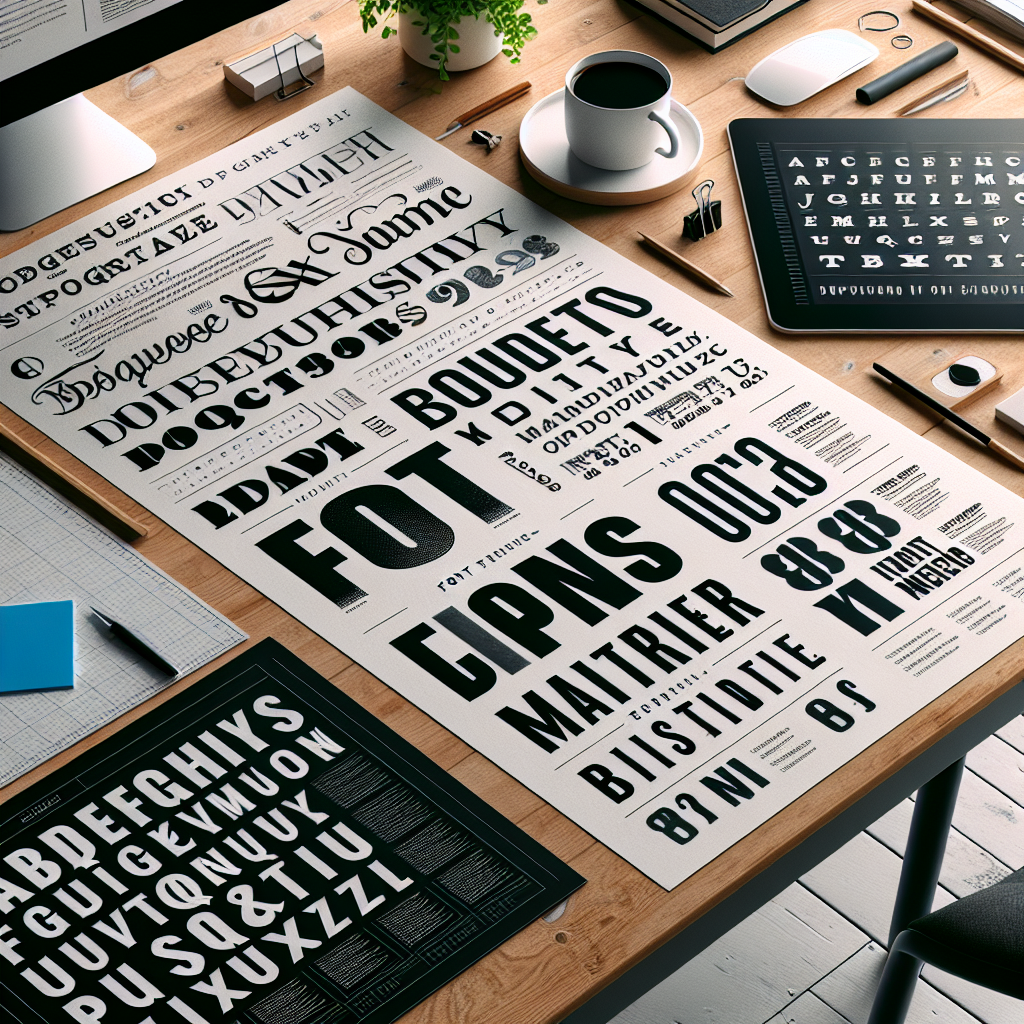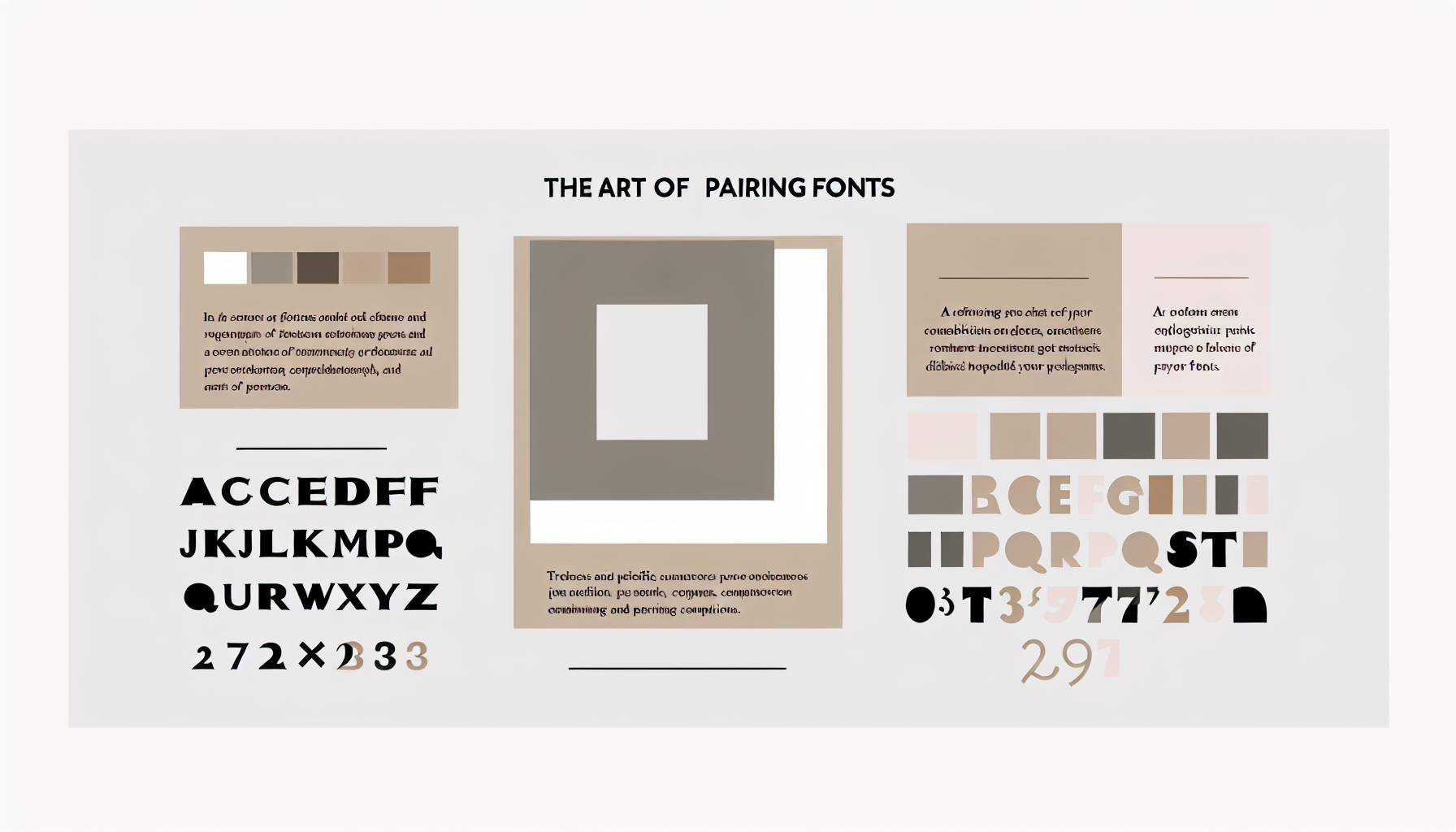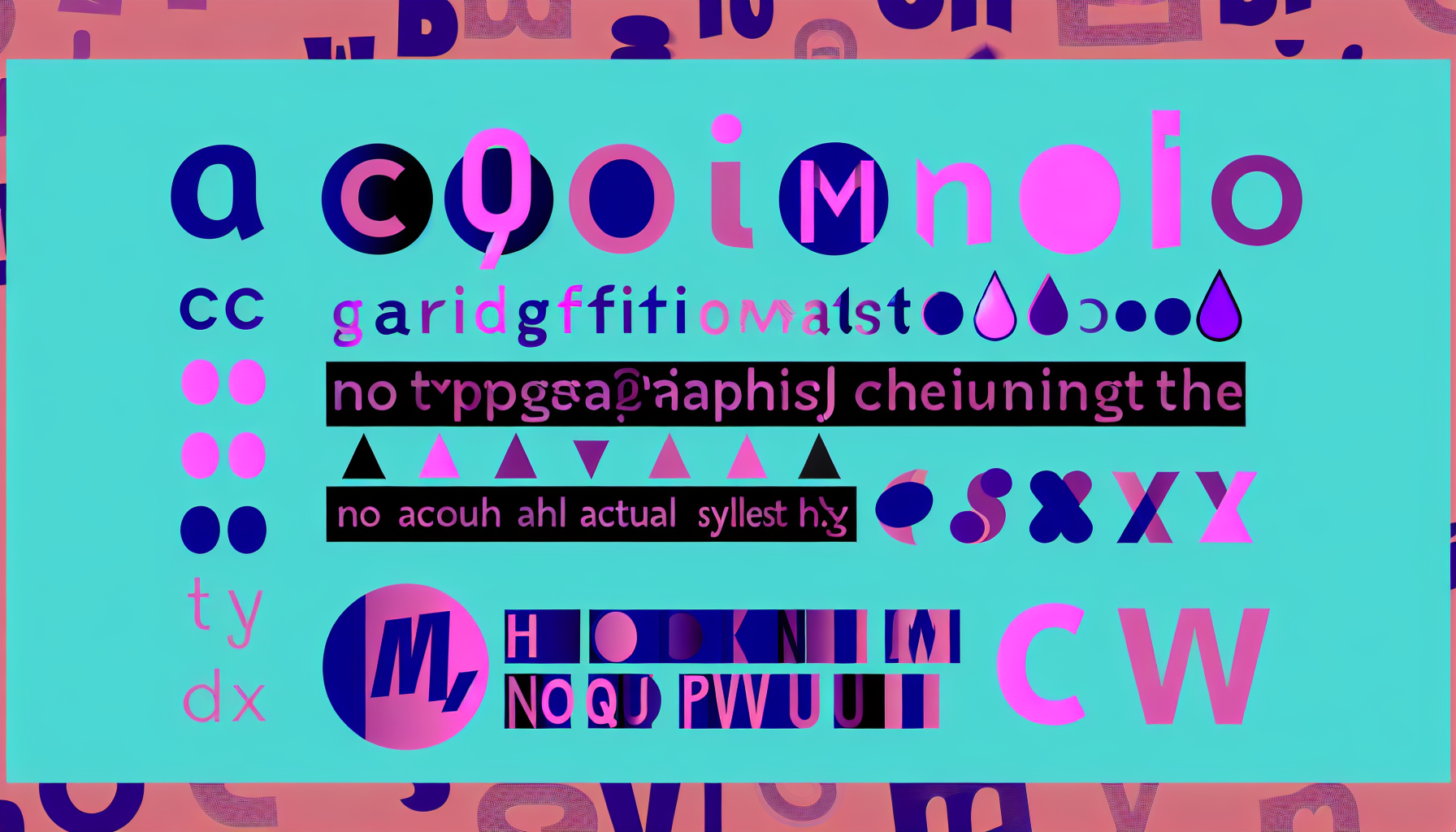Explore the art of typography with insightful tips on selecting and pairing fonts to enhance visual hierarchy in graphic design. Elevate your font combinations.

Typography is an essential component of design that encompasses the art and technique of arranging type to make written language legible, readable, and visually appealing.
It plays a pivotal role in the way we perceive text and contributes significantly to the overall user experience. Good typography enhances the communication of a message, while poor typography can lead to misunderstandings and disengagement from the content. Thus, understanding the intricacies of typography is necessary for effective design.
At its core, typography involves several basic elements, including font types, size, spacing, and alignment. Font types can be categorized into various families such as serif, sans-serif, script, and display, each conveying different emotions and associations. The size of the font is crucial as it affects readability; larger sizes typically attract attention and are easier to read, while smaller sizes can imply subtlety and elegance when used appropriately. Moreover, spacing—both between characters (kerning), words, and lines (leading)—is vital for clarity and comfort when reading.
In this blog post, we aim to explore the goals of selecting and pairing fonts effectively across different design contexts. We will discuss various strategies for choosing font styles that complement each other, taking into consideration their visual hierarchy and the emotions they evoke. By understanding these principles, designers can improve user engagement and enhance the overall aesthetic of their projects. Effective typography is not merely an artistic endeavor but a functional one that significantly impacts readability and user experience. Therefore, it is crucial for designers to invest time in mastering the art of typography.
Typography plays a crucial role in design, and understanding font categories is essential for making informed choices. Fonts can be broadly classified into several categories, each serving unique purposes and conveying different moods. The primary categories include serif, sans-serif, script, and display fonts.
Serif fonts are characterized by small decorative strokes, known as serifs, at the ends of their letters. These fonts are often considered traditional and convey a sense of reliability and formality. Popular examples include Times New Roman and Georgia. Serifs are well-suited for print materials, such as books and newspapers, as they enhance readability in long texts.
On the other hand, sans-serif fonts lack these embellishments, resulting in a clean and modern appearance. Fonts like Arial and Helvetica fall into this category. Sans-serif fonts are generally preferred for digital platforms, as they are easy to read on screens. Their minimalist aesthetic makes them appropriate for contemporary designs and branding that require a straightforward and approachable look.
Script fonts replicate the fluidity of handwriting, featuring elegant and often ornate letterforms. They can evoke feelings of warmth and personalization, making them ideal for invitations, greeting cards, and branding that seeks to impart a sense of elegance. However, script fonts should be used sparingly, as they can compromise legibility when overused or applied in lengthy texts.
Lastly, display fonts are bold and attention-grabbing, intended primarily for headlines or short text elements. These creative typefaces can vary widely in style and are often used in advertising, posters, and promotional materials. Display fonts are perfect for setting the tone of a project but should complement the overall design without overwhelming it.
Choosing the right font category is essential for effectively conveying the desired message and mood of a design. Understanding these basic categories allows designers to make informed decisions tailored to specific contexts.
Typography plays a crucial role in shaping perceptions of a brand. Each font possesses distinct characteristics that can evoke specific emotions, influencing how audiences perceive a message. For instance, serif fonts are often associated with tradition, reliability, and professionalism, making them ideal for industries like law and finance. Conversely, sans-serif fonts convey modernity, cleanliness, and simplicity, which can be appealing in tech-oriented or progressive brands. Understanding the psychological implications of font selection is essential for effective communication.
The choice of font can significantly impact the audience’s emotional response. A playful handwritten typeface might evoke a sense of fun and creativity, aligning well with brands seeking to connect with a younger demographic or emphasize a casual environment. On the other hand, a bold and geometric font may suggest strength and stability, ideally suited for brands needing to establish authority. This psychological connection underscores the importance of aligning font choices with a brand’s identity and messaging goals.
Moreover, the context in which a font is presented can alter its perception. For example, using a script font for a formal event invitation can create a sense of elegance, while the same font in a commercial campaign may dilute its intended sophistication. Thus, font pairing is essential as it can define the overall tone and ensure a harmonious balance. Brands should also consider their target audience when selecting fonts, as cultural backgrounds and personal experiences can shape individual interpretations. Understanding these nuances fosters effective storytelling through typography, reinforcing the brand’s voice and message.

Font pairing is a crucial aspect of typography that can greatly enhance the visual appeal of design projects. The selection of complementary fonts is essential to create a harmonious balance that supports the intended message. Understanding the principles of contrast, hierarchy, and unity is vital in this process. By carefully considering these elements, designers can effectively pair fonts that not only look good together but also serve distinct functions within a design.
Contrast is one of the most important principles to consider when pairing fonts. Pairing a bold serif typeface with a light sans-serif can create a striking visual differentiation that grabs attention. For example, using a modern sans-serif font for body text can contrast beautifully with a traditional serif for headlines, drawing the viewer’s eye and establishing a clear visual hierarchy. This technique is particularly effective in digital mediums where readability is critical and can greatly impact user experience.
Hierarchy involves organizing text in a way that conveys the importance of the content. It helps guide the reader through the information presented. A well-defined hierarchy can be established by varying font sizes, weights, and styles. Consider the famous pairing of Helvetica and Garamond; Helvetica can be employed for headings due to its strong presence, while Garamond works well for body text, providing a clear distinction between the two levels of text.
Unity is essential for creating a cohesive look across various typography elements. To achieve this, it is beneficial to select fonts from the same family or those that share similar characteristics, such as x-height and letterforms. For instance, pairing a condensed version of a font with its regular weight can maintain unity while allowing for interesting contrasts. Incorporating these principles will inspire readers to experiment with their typography choices, resulting in designs that are both aesthetically pleasing and effective.
Selecting the right fonts is a pivotal aspect of typography that can significantly influence the overall effectiveness of any design. To ensure that the chosen fonts resonate with the intended audience, start by considering demographic factors such as age, gender, and cultural background. Different fonts evoke varying emotions and perceptions; thus, understanding your target audience is essential in creating an engaging visual narrative.
Readability remains a critical consideration when selecting fonts. Fonts should be legible at different sizes and across various mediums. For digital applications, sans-serif fonts, such as Arial or Helvetica, often offer clearer visibility on screens, while serif fonts like Times New Roman might be more suitable for print materials. It’s advisable to also evaluate the spacing between characters and lines, known as kerning and leading, to enhance readability and create a pleasing aesthetic. Experimenting with these parameters can lead to significant improvements in how the text is perceived.
Moreover, testing fonts in various contexts is crucial prior to final commercialization. Implementing usability testing where potential users can provide feedback on the font choices can lead to valuable insights. This method allows designers to observe how fonts perform in different scenarios, such as in email campaigns, on websites, or within mobile applications. Understanding how a font interacts in real-world applications helps refine selections and ensures that the typography aligns with the overall goals of the project.
In addition to these considerations, numerous online resources and tools can assist in font selection. Websites such as Google Fonts and Adobe Fonts offer extensive libraries to explore diverse font options, complete with filters for various attributes like weight and style. Utilizing these tools can simplify the process of finding the ideal font pairing and ensure coherence within design projects.
Typography plays a crucial role in the accessibility of written content. Ensuring that fonts are legible for all users, including those with visual impairments, is a vital consideration in modern design practices. When selecting fonts, one should prioritize clarity and ease of reading to enhance the overall user experience. This can be achieved by evaluating key factors such as font size, contrast, and spacing.
Font size is a primary determinant of legibility. The standard minimum size for body text is often recommended to be at least 12 points. However, this may vary depending on the typeface and the target audience. For individuals with diminished vision, larger font sizes improve readability. Additionally, using relative units like ems or percentages can allow for scalable typography, accommodating various screen sizes and user preferences.
Contrast between the text and background is another essential element in accessibility. High contrast, such as dark text on a light background or vice versa, facilitates easier reading. It is advisable to avoid color combinations that may be difficult for those with color blindness to distinguish. Tools are available to check color contrast ratios, ensuring that your choices meet accessibility standards, such as the Web Content Accessibility Guidelines (WCAG).
Spacing also plays a significant role in readability. Adequate line height (leading) gives the text room to breathe, making it easier to read without leading to visual clutter. Similarly, letter spacing (tracking) should be applied judiciously to avoid cramped text, which can hinder comprehension. By employing generous spacing, designers promote better readability for users with dyslexia or other reading challenges.
Incorporating these principles into typography allows for a more inclusive design, ensuring that all individuals can engage effectively with content. Accessibility in typography is not merely a requirement but an essential practice that enriches the user experience and fosters inclusivity across diverse audiences.
Examining effective font pairings offers valuable insights into how typography influences user experience and engagement. One exemplary case study is the website of the design agency, Stripe. The agency employs a seamless blend of the sans-serif font “Inter” for body text and the handwritten-style font “Fredericka the Great” for headings. This combination not only enhances the readability of the content but also injects a playful character into the design, capturing the creative essence of the brand. The rational selection of fonts contributes to a strong visual hierarchy, guiding users through the website while reinforcing the agency’s personality.
In the realm of print design, the branding of the upscale coffee shop, Blue Bottle Coffee, serves as a remarkable case study. The company pairs “Helvetica Neue,” a well-structured sans-serif font, with “Baskerville,” a classic serif typeface. This dynamic combination exudes sophistication while remaining approachable. The serif’s traditional roots contrast beautifully with the modern sans-serif, creating an engaging visual narrative that attracts coffee enthusiasts and signifies the brand’s commitment to quality. The effective pairing not only enhances the aesthetic appeal of their packaging and promotional materials but also strengthens brand recognition and customer loyalty.
Finally, a noteworthy example from the realm of advertising is the iconic campaign by Apple for the iPhone. They utilized the clean aesthetic of “San Francisco,” Apple’s own sans-serif typeface, alongside “Avenir,” which conveys modernity and accessibility. This pairing facilitated easy readability and consistency across various media, whether online or offline. By thoughtfully integrating these fonts, Apple emphasizes clarity and innovation, appealing to their tech-savvy demographic while maintaining brand integrity.
Through these case studies, it becomes evident that intentional font pairings can significantly enhance both branding and user experience, offering a wealth of lessons for designers and marketers alike.
Choosing the right fonts for a project is essential in creating an effective visual communication strategy. However, many designers encounter common pitfalls that can undermine the impact of their typography. One prevalent mistake is the inclination to use too many fonts within a single design. While variety can enhance creativity, it often leads to a cluttered appearance that confuses the viewer. A best practice is to limit font usage to two or three complementary typefaces that share similar characteristics, allowing for harmony without sacrificing interest.
Another frequent issue arises from neglecting readability. Selecting fashionable fonts can be tempting, but if they compromise readability, the message may be lost. This is particularly critical when text is displayed in smaller sizes or against busy backgrounds. Prioritizing legibility should always be a primary consideration. Designers can avoid this mistake by testing font size and weights against various backgrounds and ensuring adequate contrast to optimize viewer comprehension.
Additionally, mismatching font styles is a common error. Pairing fonts that do not complement each other, whether through contrasting weights or incongruent styles, can lead to visual dissonance. For example, combining a modern sans-serif with an ornate script may create a jarring effect rather than enhancing the overall design aesthetic. To prevent this, designers should consider the mood and context of the project. Using typefaces from the same family or selecting fonts with contrasting but complementary qualities can foster unity in a design scheme.
By being aware of these mistakes and implementing best practices, designers can significantly enhance their typography choices. Mindful selection and pairing of fonts are vital to effective communication, ensuring that the intended message is not only conveyed but also aesthetically pleasing.

Once you have selected a combination of fonts, it is imperative to assess their effectiveness in conveying your intended message. Testing your typography choices is an essential step in ensuring that the fonts resonate with your targeted audience, enhance readability, and establish a cohesive visual identity. One widely adopted approach for testing typography is A/B testing, which involves presenting two variations of content to different audience segments. By varying typography, you can measure user engagement and preference, determining which font pairing yields more favorable results.
Another valuable method is collecting user feedback. Engaging with your audience through surveys or direct inquiries can provide insights into their perceptions of your font choices. When seeking feedback, consider focusing on specific aspects such as legibility, emotional response, and overall visual appeal. For instance, if you’re designing a website, you might compare a sans-serif font with a serif font and ask users which one they find more appealing and easier to read.
Once you gather data from A/B testing and user feedback, the next step is to refine your font selections accordingly. Analyzing results may reveal certain pairings that perform significantly better than others. For instance, you might discover that a combination of a bold headline font with a lighter body font offers a more prominent and visually engaging layout than two contrasting styles. This knowledge allows you to make informed decisions moving forward, ensuring that your typography aligns with both your branding and user expectations.
In summary, testing typography choices through methods such as A/B testing and user feedback is crucial for refining your font selections. By implementing these strategies, you not only improve the effectiveness of your designs but also enhance overall audience engagement, laying the groundwork for successful communication through typography.
Typography plays a critical role in the overall effectiveness of design, influencing both readability and the emotional response of the audience. As we have explored throughout this post, selecting and pairing fonts requires careful consideration of various factors, including context, hierarchy, and typography principles. It is essential to understand that each typeface conveys unique meanings and associations, which may enhance or detract from the intended message. Therefore, taking the time to thoughtfully choose typography can elevate a design from ordinary to extraordinary.
The key takeaways from this discussion highlight the importance of understanding font families, the impact of contrasting typefaces, and the significance of maintaining consistency. By integrating diverse typographic elements, one can create visual harmony that guides viewers through content seamlessly. Additionally, utilizing tools such as typographic scales can further assist designers in establishing a coherent structure in their work.
Moreover, experimenting with different pairings is encouraged, as this exploration can lead to discovering unique combinations that resonate with specific audiences. It is beneficial to regularly assess design choices, reflecting on whether the selected typography aligns with the overarching goals of the project. Refining typography skills is an ongoing process, and designers should continually seek inspiration from various sources including contemporary design trends and historical references.
In conclusion, mastering typography is a journey that significantly impacts design outcomes. By applying the insights gained from this discussion and embracing the art of font selection and pairing, designers can create impactful visual communication that captivates and engages audiences effectively. The interplay between type and design is an art form worth mastering, so let your creativity flourish as you refine your typography skills.
Find Scholarships Offered by Countries Worldwide for Your Academic Goals.
Chose where you want to study, and we will let you know with more updates.